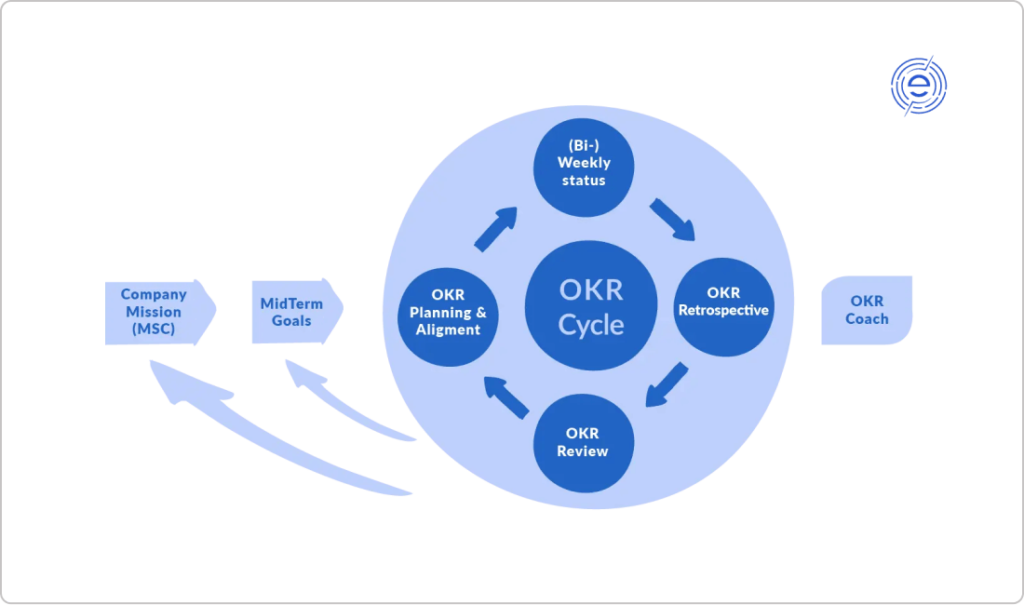In almost all businesses, management relies heavily on measurement.
Whether they're a marketing manager trying to improve conversions or a business development manager trying to increase revenue, managers need metrics to understand how they're doing. Optimizing conversion rate is a common objective for many businesses, and incorporating it into your OKR cycle can help improve overall performance.
Those metrics are your Key Performance Indicators (KPIs). Deciding what those are is an essential first step, but in a busy organization, it's easy for them to be neglected in favor of what's immediately in front of you. Tying those KPIs into more actionable Objectives and Key Results (OKRs) is great, but you'll have the same problem without an OKR cycle to keep the whole business focused on them.
Without an OKR cycle, teams can quickly lose sight of the long-term company strategy while "fighting fires" day-to-day.
In this article, we'll cover what an OKR cycle is, how to monitor and maintain one, and some best practices for making sure it's implemented smoothly.
What Is an OKR Cycle?
An OKR cycle is a repeated process of goal-setting and performance tracking across the business. It is a structured approach to setting and monitoring OKRs that will keep everyone aligned on the overall business strategy for that year.
The OKR process typically involves setting an overall goal, finding KPIs that can be pinned to it, and clearly defining the intended result. For example:
- Objective: Increase B2B revenue.
- Key Results: Number of leads currently in the sales funnel, number of weekly conversions, average customer lifetime value of B2B accounts, expected monthly spend of customers who joined in the past 60 days.
The OKR cycle includes regular meetings to review the OKRs, where adjustments can be made, to ensure that the objectives are still achievable and aligned with the needs of the business.
These regular progress reviews are an essential component of this cycle and can provide actionable feedback for both managers and their employees.

Image Credit: Adapt Methodology
What Are the Different Phases of a Typical OKR Cycle?
You can start your OKR cycle at the beginning of any quarter, but for this example's sake, we'll assume you're coming up with a plan for the next year.
6 Weeks before the Year Ends
Managers should begin planning OKRs for the year ahead of time.
If this is the company's first OKR cycle, an initial meeting with the whole executive team should introduce the concept, the planning process, the cadence of meetings, and practices around communication. The point should be to make sure everyone is informed and to get buy-in from everyone on whom this plan depends.
Then, they should develop a broad yearly plan and set OKRs for Q1. Plans and OKRs should be made available for all staff, and managers at all levels should welcome feedback from their teams.
1 Week before the Quarter Ends
Before the beginning of each quarter, all stakeholders responsible for OKRs should meet. The purpose of these meetings is to confirm objectives, ensure alignment between teams, and identify where teams need to work together. This meeting also allows for any last-minute changes to the OKRs.
2 Weeks into the Cycle
Two weeks into the OKR cycle, individual teams should start reviewing their progress through brief weekly or bi-weekly check-ins. These meetings provide a high-level overview of the team's progress on KPIs since the last meeting rather than an exhaustive review of all objectives.
6 Weeks into the Cycle
Managers should hold check-in meetings to assess overall progress and discuss any issues that are coming up. During these meetings, they should evaluate all objectives and figure out where improvements can be made to make sure KPIs are going in the right direction.
End of the Cycle
At the end of each cycle - whether quarterly or yearly - a meeting should be held with all managers responsible for OKRs. This will evaluate progress for the quarter and help to finalize the next quarter's OKRs, which are then disseminated to all teams and departments. Considering the difference between KPIs and OKRs, while KPIs tend not to change, OKRs should respond to the business's main priorities for the near- to mid-term future.
What Are the OKR Cycle Best Practices?
Sticking to an OKR cycle is a big commitment. When implementing it for the first time at your company, there are several best practices to keep in mind.
1. Start with Why
When coming up with OKRs and an OKR cycle, it's important to "start with why".
Following Simon Sinek's famous TED Talk, you can more easily get buy-in from stakeholders by emphasizing the values and purpose behind what you're doing. Once that vision is laid out, you can get into the details of how you're going to implement it.
When everyone has a clear picture of the why, they can better understand the decisions being made and easily identify the goals that need to be achieved. This helps to create a unified and inspired team while they work to achieve the objectives that were set out.
2. Habitual Communication
In an organization where everyone is busy with their own tasks, it's easy for people to lose track of what's going on elsewhere in the company. This is why it's important to implement "habitual communication". This ensures that information is communicated at regular intervals, not whenever it's convenient to sit down and write a memo and that everyone is kept in the loop.
This could take many forms, such as a weekly company email or a Slack bot that prompts people to share what they're doing. In a globally distributed team, weekly conference calls from Canada to the offices in Europe can help teams keep an eye on OKRs, even if it's just a quick check-in. The point of "habitual" communication is that it becomes second nature over time, so it's not an inconvenience for a busy team to do it.
Effective employee communication is essential for the success of an OKR cycle. Regular communication and updates with all team members can help keep everyone aligned on the overall business strategy and ensure that goals are being achieved.
3. Consider the Duration of OKRs
In general, there are two OKR cycles: yearly and quarterly.
The quarterly cycle is a much faster approach to setting and achieving goals. Three months is enough time to work on big projects, but it's short enough to make room for iteration.
The yearly cycle is less frequent, but this makes room for big, open-ended goals like "increase operational efficiency". There are many ways to attack that problem, some of which take much longer than a quarter to complete.
What Are the Benefits of OKR Cycles?

Benefits of Quarterly OKRs
Quarterly cycles encourage teams to focus on short-term priorities, which ensures that goals are relevant and up-to-date. More frequent meetings on these cycles allow for more frequent adjustments to be made. This enables fast course correction and makes room for teams to capitalize on opportunities that emerge in the market.
Furthermore, quarterly OKRs promote a sense of urgency and accountability in teams. Shorter time-frames encourage teams to think and act quickly, and a smaller timescale for OKRs usually means a smaller scope: there's less room for individual people to "hide" when the project is a small one.
And with shorter cycles, post-mortem Agile retrospectives can be done more frequently. If these meetings are insightful and learnings are communicated well, this leads to faster improvements in the company's operations.
Benefits of Annual OKRs
Annual OKRs give organizations the flexibility to work on bigger-picture goals and projects that might take several quarters to complete.
Annual OKRs also give teams the time to develop in-depth knowledge in a specific domain over the course of the year. This is essential if the company needs to pivot into a new industry or line of business. If a B2B company catering to one industry wants to find customers in another, that might require several months of getting to know potential customers, networks, and partners.
Quarterly and annual OKR cycles aren't an either/or choice. A big project can be split up into quarterly objectives, which helps companies move quickly and demonstrate clear progress even though they're thinking about the long term. And with more frequent iteration cycles, reporting on quarterly OKRs can help teams learn from unexpected problems and refine their vision for completing the year's objective.
Benefits of Check-ins and Stand-ups
When your OKR cycle is being implemented for the first time, it's important to closely monitor how it's progressing and quickly identify what isn't working. You can achieve this with regular updates and check-ins with the team. That could be synchronous, like a regular group call, or asynchronous, like a quick message in your system's visual voicemail feature.
At an even smaller scale, daily "stand-up" meetings (or "scrums") create a feeling of accountability and motivate teams to stay on track with their goals for the day, week, month, or quarter. The stand up meeting is a practice taken from the Agile methodology, which is complementary to the OKR cycle.
Benefits of an OKR Review
You don't need to handle all your OKRs in one big weekly meeting. Actually, you might find it easier if each meeting just focussed on one. The frequency of meetings and check-ins should reflect the urgency of the OKR. It makes sense for quarterly OKRs to be tracked on a week-to-week basis. Yearly OKRs, which should be supported by the quarterly ones, need less frequent check-ins.
But at the end of the OKR cycle, it's important to get all stakeholders together for a review. Two weeks before each OKR cycle ends, progress and achievements are evaluated and documented. This allows teams to determine whether the OKRs have been successful.
Insights gained from this evaluation are used to form goals for the next cycle, which are usually presented at a company event. The review of the previous cycle and drafting of the new one can usually be integrated into one meeting.
The OKR Cycle: Optimizing Goal-Setting and Completion
OKRs are a tried-and-true way to set and complete goals, and the OKR cycle is essential to keeping those goals in view over the course of a year. With regular reviews at varying scales, teams can keep track of their most important objectives and learn how to be more effective as they go on.

Jenna Bunnell
Guest Author
Jenna Bunnell is the Senior Manager for Content Marketing at Dialpad, an AI-incorporated cloud-hosted unified communications system that provides valuable call details for business owners and sales representatives. She is driven and passionate about communicating a brand's design sensibility and visualizing how content can be presented in creative and comprehensive ways.



